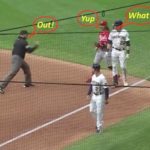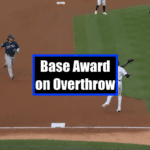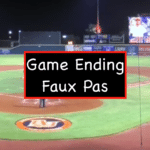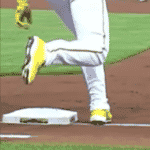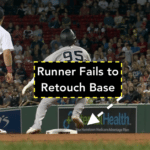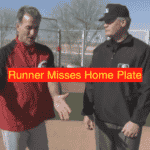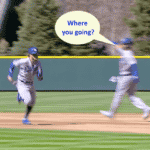RETOUCHING BASES WHILE BALL IS DEAD
Rule 5.09(c)(2):
While the ball is dead, no runner may return to touch a missed base or one he has left too soon after he has advanced to and touched a base beyond the missed base. A runner may return to a missed base (or one he has left too soon) during the time the ball is dead if he has not touched the next base. A runner may, of course, return to any missed base (or one he has left too soon) while the ball is in play unless a following runner has scored. See Approved Rulings (A) and (B) to Official Baseball Rule 5.09(c)(2). The “next base” or “base beyond” in this section refers to the position of the runner at the time the ball went out of play.
EXAMPLES:
(1) Batter hits a home run out of the ballpark or a ground-rule double and misses first base (ball is dead).
Ruling: The batter-runner may return to first base to correct the mistake before touching second; but if the batter-runner touches second he may not return to first, and if defensive team appeals the batter-runner is declared out at first.
(2) Batter hits a ball to shortstop who throws wild into stands (ball is dead); batter-runner misses first base but is awarded second base on the overthrow. Ruling: Even though the umpire has awarded the batter-runner second base on the overthrow, the batter-runner must touch first base before touching second base. If the batter-runner does not return to first base before touching second, the batter-runner would be out on appeal at first.
(3) Batter hits single to right field and misses first base in rounding it. Right fielder makes quick throw to first baseman in an attempt to pick off the batterrunner, who has rounded the base. However, the right fielder’s throw is wild and goes into the dugout.
Ruling: Batter-runner is awarded third base. However, the batter-runner must return to and touch first base before touching second. While the ball is dead, the batter-runner may return to first base to correct the error before touching second; but if the batter-runner touches second he may not return to first, and if the defensive team appeals, the batter-runner is declared out at first.
(4) Runner on second base, no outs. Batter hits fly ball to right field that is caught for the first out. Runner at second base leaves too soon. Runner slides into third base safely, but the right fielder’s throw goes into the dugout.
Ruling: Runner is awarded home. However, while the ball is dead the runner must return to and retouch second base. Furthermore, because the runner had already reached third base before the ball went out of play, the runner must return to second base before touching home (his next base). If the runner touches home, the runner may not return to second, and if the defense appeals the runner is declared out at second.
(5) Runners on first and second, one out. Batter hits deep fly ball that is caught by right fielder. The runner from second was running when the ball was hit, did not tag up, and proceeds to touch and round third base. After the runner from second has rounded third base, the right fielder throws behind the runner from first, who is returning to first base. The fielder’s throw is wild and goes out of play. The umpires call “Time” and award the runners home and third. When the umpires call “Time” the runner from second is between third and home, and the runner from first is between first and second. At this point the manager yells to the runner from second (who is between third and home) to go back and tag up at second base. Is this permissible, or is the runner considered a “base beyond” the base the runner left too soon?
Ruling: It is permissible for the runner to return to second base while the
ball is dead. When the ball went out of play the runner originally on second base
was past third (between third and home). The runner’s “next base” is therefore
home. While the ball is dead the runner may return to second base and retouch
at any time prior to touching home plate. However, if the runner advances to and
touches home while the ball is dead, the runner may not return.
(6) Runner on first base, one out. Hit-and-run. Batter hits a line drive to the shortstop, who catches the ball for the second out. Shortstop’s throw to first is wild and goes into the stands. Runner originally on first is between first and second when the wild throw is made and goes out of play.
Ruling: Runner is awarded third. However, while the ball is dead, the runner must return to and retouch first base before touching second on the way to third. If the runner touches second, the runner may not return to first, and if the defensive team appeals the runner is declared out at first.
(7) Runner on first base, hit-and-run. Batter hits a fly ball to left field that is caught. The runner touches second in advancing but misses second on the way back to first. The throw back to first base is wild and goes into the stands. When the wild throw was made the runner was between first and second.
Ruling: Runner is awarded third base. If the runner retouches first and then second in advancing to the awarded base, the runner’s failure to touch second base in returning to first is “corrected” under the theory that touching the base the “last time by” corrects any previous error.

